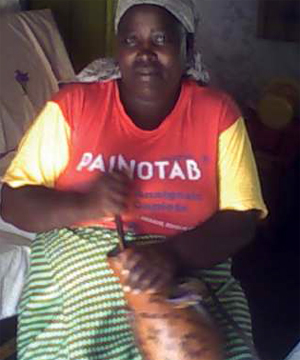The Kalenjin community from the Rift Valley is famous for giving returning champions a drink of traditionally fermented milk known as Mursik from a colourful gourd or sotet. This article highlights the process of making the nutricious Mursik.

Origin of Mursik
Mursik technology originates from the Kalenjin community for whom milk is a staple diet. The community developed the unique milk preservation technology using indigenous tree species about 300 years ago. The technology evolved as a result of the need to avoid wastage by preserving and storing excess milk for use during the dry season.
Mursik preparation
Milk treatment is traditionally the preserve of women; however men do sometimes practice the art. Extreme care must be taken during the gourd preparation and milk fermentation processes and high hygiene standards must be observed to avoid potential food poisoning.
Depending on the availability of milk, a large quantity of Mursik can be prepared at once or alternatively small quantities of milk can be poured into a prepared gourd on a daily basis until it is full. The fermented milk provides the culture for the new milk and accelerates the process of fermentation. The flavour of Mursik is determined by various factors including the quality of milk used, technique of cleaning the gourd, time taken before the milk is served, and to some extent the tree species used to treat the gourd. Factors determining the quality of a cows’ milk include: stage of lactation; cow breed and; the cow’s diet.
Materials and Tools for Making Mursik
- Gourd (preferably dry), fresh one can also do so long as it is fully ripe.
- Sharp machete or large knife
- Palm tree branches
- Cow urine
- Clean water
- Dry ash
- A piece of cow hide
- Several dry sticks from a milk preserving tree species (preferably Cassia didymobotrya)
- A bow shaped palm stick (sosiot) without bristles
- Fire
- Milk in a clean container with a lid
- Water
Steps in Making Mursik
- Preparing the gourd: Cut the top of the gourd systemically using the machete or knife. Remove the seeds and pour a mixture of water and ash into the gourd. Cork the gourd and put it aside for a few days. Pour out the water in readiness for cleaning and treating the gourd.
- Cleaning the gourd: Take some branches of the palm tree and hit them on a firm surface such as a tree trunk until the edges form brush like bristles. Using the stiff bristles remove the inner lining of the new gourd in order to ensure that the milk does not acquire the bitter taste of the gourd. Pour some cow urine into the gourd and put it aside for a few days for curing and seasoning. Pour out the cow urine and use a bow shaped palm stick (sosiot) to clean the gourd again.
- Treating the gourd: Take a few sticks from the selected milk preserving tree species and burn the tips them into charcoal. Put the burning embers inside a clean and dry gourd, shaking it to avoid burning. Using the bow shaped palm stick grind the embers by pressing them against the walls of the gourd using the sosiot in a methodical, circular in and out movement of the hand. Repeat the grinding movement until the inside of the gourd is evenly covered with fine dust. Pour out any large particles and excess coal dust and allow the gourd to cool down.
- Preparing and treating the gourd lid: Prepare a well designed, tightly fitting lid for the gourd using animal hide/skin. Test the lid to make sure it its tightly into the mouth of the gourd. Treat the inner side of the lid with charcoal dust using the method for cleaning and treating the gourd.
- Milking, boiling and cooling the milk: Milk the cow and boil the fresh milk immediately. Cover the boiled milk to avoid contamination and allow it to cool down. Traditionally the cow was milked directly into a treated gourd and the milk would be mixed with some blood and stored in a cool place to ripen. However this practice has since ceased due to a change in lifestyles and widespread awareness of the need to improve hygiene standards.
- Fermentation: Pour the cold boiled milk into a treated gourd or sotet. Cork the gourd tightly with the treated lid. Store the Mursik in a cool dry place for about one week to allow it to ripen until it achieves the consistency of sour milk.
- Shaking and serving the Mursik: Shake the Mursik well to ensure it has a smooth, uniform consistency. After thorough shaking, good quality Mursik is a clear liquid with a sharp taste that is almost bitter in some cases, in which white globules of butter float. Systematic tapping on the skin lid produces a popping sound, allowing excess air to escape. Mursik is best taken during the dry season or on a sunny day and served cold with hot ugali, a Kenyan staple food made of maize/corn lour, millet, sorghum, or a mixture of different types of flour.

Milk treatment and Environmental Conservation
The use of some tree species for milk preservation and flavouring is part of indigenous knowledge that also helps in conservation of biodiversity. Cassia didymobotrya is native to Eastern Central Africa and the most preferred tree species for milk treatment.
Cassia didymobotrya is locally known by different names, for example senetwet (Kipsigis); Inyumganai (Kamba); Mwino (Kikuyu); Lubino (Luhya); Obino (Luo); Osenetoi (Maasai) and ndimu or limau (Swahili). The shrub grows well near cattle bomas (sheds) especially near decomposed cow dung. It prefers well-drained soils, can withstand occasional drought and is propagated through seeds, which readily germinate. Its leaves are evergreen with elliptic to oval leaflets and yellow ornamental lowers, which appear for prolonged periods in warm climates (Mureithi, 1997). Animals rarely feed on cassia leaves; therefore it has a survival rate of almost 100 percent.
Other tree species used for milk preservation
Other tree species used for Mursik preparation are: Lantana kitu (Muokiot), Olea afrikana (Emitiot) Rhus natalensis (Natal Rhus), Olea capensis, Acacia meansii and Prunus africana’ among others.
Conclusion
Milk is a locally available and easily accessible commodity and value addition through the use of Mursik technology has proved highly successful. Adoption of Mursik technology by non-pastoralist communities has introduced the element of its commercialization as a viable source of income for livestock farmers.
As a valuable tree species Cassia didymobotrya deserves the attention of researchers to ensure its conservation and to explore its anti-bacterial effects, among other useful characteristics. There is need to preserve gourd planting, cutting and cleaning technology since gourds are cheap and easily accessible, making them ideal storage containers for farmers.













